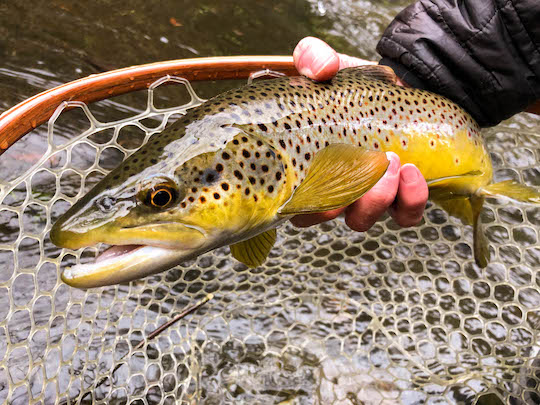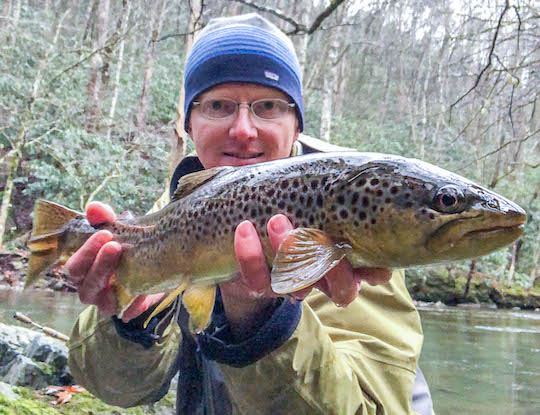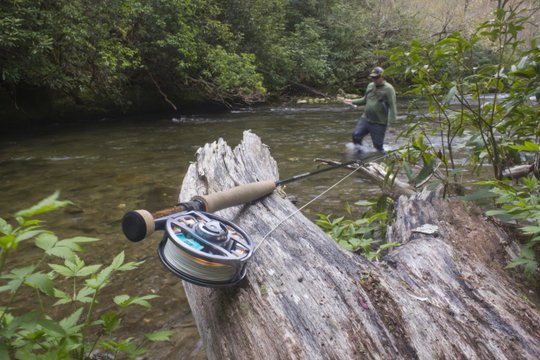Some fishing experiences tend to end in disappointment while others tend to end in elation. For example, there is a stream in the Smokies that, due to its small blue line status, will remain nameless. It looks fishy and I sometimes catch some fish there, but it never fishes nearly so well as it looks like it should. Every once in a while, I go back and give it another shot, but so far it has been mediocre. Other streams have a tendency to always impress. This has been my experience on Deep Creek in the Great Smoky Mountains National Park.
I have long said that something good always happens on Deep Creek. For me, that has historically been a memorable fish. While all the fish I catch
should be memorable, it was beginning to look like
my backpacking trip would conclude with lots of beautiful but average trout. The usual Deep Creek lunker had eluded me.
Thankfully, as we began hiking down the trail on our return to civilization, I carried with me the memory of two incredible days on the water in the Smokies. The
first day was memorable because I returned to fish a pool that had previously produced my largest brown trout on Deep Creek. The second day was memorable because I had finally achieved my long time goal of
fishing around Bumgardner Ridge. The experience had been everything I had imagined, short of 20 inch wild trout leaping onto my hook the whole way that is.
As we hiked down the trail, I began to think about one pool in particular. This pool is in the lower reaches of the creek. It is where I had broken off a rather large brown trout the year before. There are several of these big pools on Deep Creek. Bottomless pools that must contain truly large brown trout, these are the pools that keep anglers coming back and dreaming about the big one.
By this point in our trip, I was simply focused on getting back out to my car and heading home. I was already dreaming about some good home cooked food instead of the backpacking food that required rehydrating before eating. A soft bed also sounded rather nice. Clearly I'm getting soft in my old age, but the comforts of home were pulling me down the trail faster than I had hiked in a few days before. I did some quick math in my head and decided it might even be possible to make it home in time for lunch.
The thought did occur to me that I might discover a big fish. Mostly I hoped that it wouldn't happen, because if it did, then I would probably
need want to fish for it. Approaching the final pool of reckoning, I was almost scared to glance into the water. I purposefully left my polarized sunglasses off. If I couldn't see through the surface, then I couldn't find any fish.
Upon first glance, the pool seemed devoid of fish. Whew, close call, right? The smart thing at this point would have been to keep going. However, with no other anglers in sight, I couldn't help but linger. This was the pool that I had been dreaming about for over a year. I couldn't pass up the opportunity to examine every rock, every boulder, every inch, just in case that big fish was still around.
When I saw the fish, I couldn't believe my eyes. It was late enough in the morning and enough people were around that a fish that size should have already moved up into the deep heart of the pool before then. The fish looked about the same as last year, maybe a shade bigger. There wasn't much mistaking this fish though. A an opportunity for redemption was staring me in the face. The fish was clearly eating. The white of its mouth was obvious from our vantage point every time a bug drifted too close.
I had purposefully packed my wading gear inside my backpack knowing that the harder it was to get to everything, the less likely that I would actually stop to fish. This fish was in such a perfect position and looked so big, though, that I just couldn't refuse the chance to cast to it again.
Digging through my fly box, I selected a big black Kaufmann's stonefly along with the same bead head caddis pupa that I had broke the fish off on last time around. Assuming it would spook the fish, but really having no other choice, I also added the smallest airlock indicator they make. I couldn't get close enough to high stick very effectively so the indicator would have to do the trick. I took a while to sneak into position. The riffle just downstream from the pool affords a level of cover, but you still don't want to be too casual about the whole thing.
Soon I found myself kneeling in the riffle downstream of the fish. I could still see it large as life. My buddy John had dug out his GoPro and started filming. Strangely, I didn't feel any pressure. Either the fish would eat or it wouldn't. If it ate, I would either land it or I wouldn't. For some reason, spending a few nights in the woods puts things into better perspective, and I had never been more relaxed while fishing for a large trout.
After fishing for a while, the bottom fly caught the bottom just upstream of the trout. When I gently tugged to get it moving again, the large fish casually cruised up and across the pool and out of sight. Almost ready to leave, I remembered that the fish had done the same thing when I fished for it last time. Thankfully, my memory proved correct. This was a tolerant fish.
Several minutes later, I caught movement out of the corner of my eye as the fish worked back up through the riffle to my left. It casually returned to its feeding lie and sat back down. I waited another minute, absolutely certain that another cast would spook it for good. But it didn't.
Eventually, I was convinced that the fish didn't want what I was offering. I changed the dropper to a small Pheasant Tail nymph. The fish had clearly been eating when I first spotted it. It seemed to know I was there, because its feeding had nearly ceased. In fact, when it finally ate the same big black stonefly I had been throwing the whole time, it was probably the first time it had ate anything for several minutes.
The same thing had happened when I broke this fish off over a year ago. The currents are tricky in the back of this hole, and I'm convinced that the flies just finally drifted correctly through the spot. A good drift is essential to catching trout and this fish proved that yet again.
The fish tried running hard down the river. I made a beeline, running across the tailout to maintain pressure downstream. Trout will generally pull away from the pressure, so by pulling downstream, I encouraged the fish to pull back up into the home pool. With that potential crisis averted, I settled down to fighting the fish. Finally, after what seemed an eternity, the fish slid into the shallows and I grabbed its tail.
My buddy John came down the bank and graciously took some pictures for me. He also took a bit more video including of the release. I can't wait to see the final video. It is the first time I've had something filmed like that. The chance to relive that moment will be a lot of fun. In the meantime, I'm already considering how and when I can return to Deep Creek. I don't know what future trips there hold, but it will probably be something good. Oh yeah, I did make it home in time for lunch, albeit just a little late. It was worth running a little late though...
Update: Find the video
HERE.











































